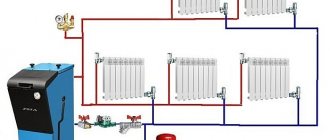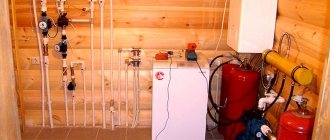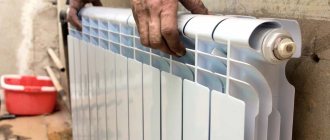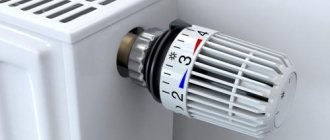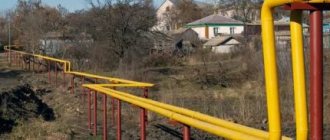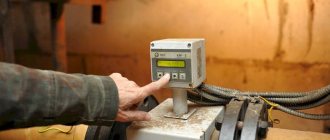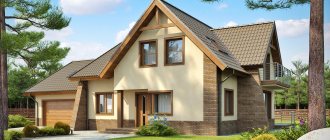Almost all construction and finishing work is carried out under certain temperature conditions. This is necessary for the process of hardening or polymerization of the solution or mixture used. But how to create the necessary conditions in an unfinished house during the cold season? Experienced developers and craftsmen share their tips regarding temporary heating. Each of the proposed options deserves attention, especially since they can be useful for summer residents, motorists (for heating the garage) and in other everyday situations.
Temporary heating: Option No. 1
One of the simplest temporary heating systems involves the use of the following elements:
• instantaneous water heater;
• circulation pump;
• thermostat;
• electricity saving devices;
• components for circuit assembly (batteries, pipes, etc.).
All of the listed components will be useful on the farm after installing a major heating system, which is a big plus for the family budget.
The scheme is quite simple, it includes the following order of arrangement of the prepared parts.
1. The circulation pump is connected to an instantaneous water heater using a metal-plastic/metal tube (the length of the connecting part is approximately 15-20 cm).
Electric heating
If a country house is connected to the electrical network, then electricity can be used to heat it. The house will, of course, be heated by hot water, not electricity.
Electricity will heat the water (coolant) to the required temperature. Boilers can be wall-mounted or floor-mounted.
The latter are distinguished by their large overall dimensions and solid weight, therefore they are installed exclusively on horizontal surfaces.
This scheme most often includes special electric boilers, which can have one (for heating needs) or several (for heating and hot water supply) independent circuits.
Quite often you can find cases of parallel installation of two boilers, one of which is used during the heating season to heat the house, and the second is intended to produce hot water used for domestic needs.
The operating principle of electric heating. Click to enlarge.
The operating principle of this scheme is not complicated. The coolant (water or antifreeze) entering the boiler expands when heated, creating the pressure necessary for movement through pipelines and radiators.
The heated batteries heat the house, and the cooled coolant, thanks to a closed cycle and established circulation, returns to the heat source for heating.
In some cases, a boiler with forced circulation is installed. This option involves the installation of additional equipment (expansion tank and additional circulation pump).
If there is no water heating system and electricity is available, it is possible to consider using other heating options, including oil or infrared heaters.
Oil heaters are characterized by safety and low electrical energy consumption.
Heating the room with infrared radiation. Click to enlarge.
Infrared heaters do not warm the entire house, but its local areas. This option, which allows for significant savings in electrical energy, is ideal for heating country houses.
Infrared emitters, which just a few years ago caused some mistrust among most homeowners, have now become very popular.
The fact is that infrared rays are not only safe for human health, but also provide some assistance in the fight against colds.
What is better (electric boiler, oil heater or infrared radiator) to heat a private house?
Each of the listed options has its own advantages and disadvantages, the optimal balance of which must be considered in the context of the individual characteristics of the house, the nature of residence, preferences and financial capabilities of its owner.
Option #3
An alternative heating solution for summer cottages or during finishing work in an unfinished house is liquefied gas. After installing heating with a gas boiler, you will need to change the nozzles to use bottled fuel. Depending on the model of boiler equipment, it may be necessary to reconfigure the control system. In addition to the cylinders, you need to purchase a reducer and shut-off valves. All wiring in the room will be preserved for further use after connection to the main gas pipeline. This justifies the cost of temporary heating. But you will need to find a place for the cylinders to prevent the fuel from freezing. It is better to place them in a special gas cabinet, which provides insulation.
Heating with coal
A good alternative to stove heating can be the installation of a coal-fired heating boiler. The fact is that in some parts of our country it is much more difficult to purchase firewood than coal.
Coal used as fuel significantly reduces the amount of harmful substances and elements formed as a result of combustion.
A country house (wooden or brick), in which a coal-fired boiler is installed, is better able (compared to stove heating) to maintain the required temperature due to the presence of special temperature sensors on the equipment.
The process of coal combustion is carried out in a furnace.
The main elements of the boiler, which can be made of cast iron or steel, are the firebox, heat exchanger and grate.
What is better (cast iron or steel boiler) to heat a house?
There is no definite answer to this question, since cast iron is a more durable material, and steel is cheaper.
Diagram of operation of a coal-fired boiler. Click to enlarge.
Both steel and cast iron boilers have a significant margin of safety, and it is quite difficult to damage their individual structural elements or completely disable them.
Advantages
The main advantages of this heat supply option include the following:
- Durability.
- Strength.
- Ability to regulate indoor temperature.
- High heat dissipation.
- Possibility of operation without electrical energy.
Flaws
Obvious disadvantages include the need for premature purchase of coal for the entire heating period and the arrangement of a special room for its storage.
Option No. 4
One of the quickest ways to ensure room heating is to install guns . There is no need to purchase equipment; heating devices can be rented. The devices operate on different types of fuel, so you have the opportunity to choose the appropriate option for yourself. Safety measures consist only in their correct operation. There is no need to attach, install or create special conditions for temporary heating.
Heating options without the use of electricity and gas
To list all the ways you can heat a country house or cottage, we will assume that electricity is still supplied there. The supplier company has set a small limit on power consumption (3-5 kW), which does not allow electricity to be used as a heat source, but makes it possible to connect heating equipment. When studying each option in detail, we will highlight those that do not require the use of an electrical network.
Houses located on the outskirts are often not gasified
So, if there is no gas and electricity (sufficient power), then heating for the house can be organized in the following ways:
- Install a stove or solid fuel boiler connected to a water heating system. Use firewood, coal, fuel briquettes or pellets as an energy source.
- Arrange autonomous heating with liquefied propane from a ramp with cylinders or a gas holder. The heat source will be a conventional gas boiler or convectors that heat the rooms with warm air.
- Use diesel fuel and waste oil to generate heat by installing the appropriate equipment.
- Draw energy from renewable natural sources, using solar collectors and a heat pump for alternative heating of a country house.
Note. Unfortunately, almost all of these methods become useless when you need to decide how to heat your apartment. We will have to do without liquefied gas and firewood, and liquid fuel is out of the question. There is only one way out - economical heating with electricity using infrared heaters or an air-to-air heat pump (in the southern regions an inverter air conditioner will do).
Options for heating equipment for an apartment
Let’s highlight heat sources that do not require a connection to the house electrical network to operate:
- metal and brick wood stoves, fireplaces;
- solid fuel boilers, equipped with a mechanical draft regulator and working in conjunction with a gravity (gravity) heating system;
- non-volatile floor-standing boilers capable of operating on liquefied gas and connected to a water gravity system with radiators.
To implement other methods, electricity is required, albeit in small quantities. If you do not take into account various home-made devices, then to burn diesel fuel you need a burner with a pump and a fan powered from the mains. The same is the case with all heat pumps and TT boilers with forced air supply, including pellet ones. Now let’s take a closer look at ways to heat a country house or cottage if there is no gas and the electricity supply is limited.
Solid fuel combustion
One of the most common methods for heating a house without gas is the use of coal, firewood and briquettes compressed from various biomass waste (sawdust, straw, sunflower husks, pine needles, and so on). To burn them and obtain the required amount of heat, a variety of furnaces and boilers are used. The former are designed for direct heating of indoor air, the latter work with water systems - radiators or heated floors.
The easiest option is to install a nice metal stove
Amendment. In a room where a wood or coal stove is located, heat spreads not only by convection from heating the air, but also by infrared radiation emitted by its heated walls.
Heating stoves come in three types: steel, cast iron and brick. The positive aspects of their operation are as follows:
- Heating your home with a steel or cast iron stove is the cheapest and easiest way. To install and launch it, it is not necessary to invite specialists; everything can be done with your own hands.
- A stationary brick stove is capable of heating several rooms, accumulating a large amount of heat in the thickness of the walls.
- Any of these heat sources can be adapted for cooking, drying clothes and shoes.
- The design of many stoves includes a water circuit built into the firebox in the form of a tank or coil connected to several radiators located in adjacent rooms. There is a point here: to move the coolant, you need to lay pipes of increased diameter in compliance with the slope (gravity system) or install a circulation pump.
- Firewood and coal are the cheapest fuels among all energy sources, so heating costs are acceptable for most homeowners.
- Ovens do not require electricity at all.
A brick stove provides pleasant, healthy warmth, but it’s not easy to build.
Note. A heat source such as a wood fireplace cannot be ruled out. True, it is enough to heat only one room in which it is located.
There were also some negative aspects:
- stove heating of a private house without gas means chopping and carrying firewood, loading it and daily cleaning of ash;
- for the heater to operate, a chimney with good natural draft is required;
- metal stoves are not capable of heating large country cottages; their power is only enough for a country house or 1-2 rooms;
- erecting a brick oven is not a cheap pleasure, and a place for it must be provided at the stage of design and construction of the building.
It must be taken into account that a brick stove is built on a foundation.
Heating a stone or wooden house using a water system with a solid fuel boiler is more economical, since the efficiency of these units is higher (75% versus a maximum of 60% for stoves). Due to this, the combustion duration from one fuel load increases, plus the issue of complete heating of the building by heating devices distributed throughout the rooms has been resolved. This creates the possibility of heating large areas of the house in the absence of gas and regulating the intensity of heating of the premises.
TT boiler with mechanical draft regulator in operation
Otherwise, TT boilers inherit the operating features of furnaces. They also need a chimney, periodic cleaning and loading of new portions of firewood and coal. If we compare the cost, then installing a solid fuel boiler together with the system occupies a middle position between buying a metal stove and building a brick one.
Important point. A water heating unit that runs on wood or briquettes can be installed in any habitable home. If there is not enough space, an extension is made to the building where heating equipment is installed.
Separately, it is worth mentioning automatic pellet boilers, which greatly simplify the life of the homeowner, since they need to be cleaned and fuel added once a week. Another thing is the price of equipment and fuel, and also the increased consumption of electricity. In addition to automation, such heat generators use the following electrical installations:
- feed auger motor;
- electric motor of a fan - blower or smoke exhauster;
- heating element used for automatic ignition of pellets.
An automatic pellet or coal boiler is an excellent choice, but it also needs electricity.
The listed elements are installed in a pellet burner and in total consume about 500 W from the mains, which is significant for a private home without gas and with a limited limit on the use of electricity. On the other hand, pellet boilers are more efficient and economical than conventional ones (efficiency - 80% versus 75%), and their operation is more comfortable and safe (automation will prevent the unit from boiling). The question is the financial capabilities of the homeowner and the amount of the allocated electrical power limit.
Heating with liquefied gas
Let us immediately make a reservation that in the absence of main gas and electricity, it is not profitable to use this fuel in all countries of the former USSR. While Russian prices for liquefied propane still allow it to heat houses, in Ukraine this method is practically not used anywhere, because the fuel is too expensive. You can see the exact breakdown of the cost of heating with different energy carriers in this article.
Any gas heat generator is suitable for working on propane, only a wall-mounted one will have to be connected to the mains
To burn a propane-butane mixture, you will need a regular gas boiler, preferably a non-volatile floor-mounted one, so as not to connect electricity to it. Accordingly, the heating system is water gravity with an open type expansion tank. Gas is supplied to the boiler in two ways - from a ramp with cylinders or from a large underground tank - a gas tank.
When installing and operating the equipment, you will encounter the following points:
- Installing a gas train with cylinders (at least 4 pieces are required) will be inexpensive, but the cash costs will have to be offset by labor costs. If you live permanently, you will have to worry about transporting and refilling cylinders much more than if you heat your house with wood.
- Installing a gas tank is a costly undertaking. But as a result, you will get autonomous heating without connecting to the gas main.
- Liquefied propane is no less efficient and comfortable energy carrier than natural gas, and provides the same advantages during equipment operation.
Methods for supplying liquefied fuel to the heat generator
Advice. It is better to organize heating with cylinders in a small country house, where you visit and live for 2-3 days. Our experienced expert Vladimir Sukhorukov will tell you more about all the nuances of using liquefied gas in his video:
Diesel fuel – more disadvantages than advantages
As a rule, burning diesel fuel and used engine oil is carried out in situations where there is nothing else to heat a private house. Sometimes this option is used as a temporary option while the built house is not yet connected to the natural gas main. In this case, you buy a universal gas boiler, temporarily equipped with a diesel burner.
The unpopularity of liquid fuel as an energy carrier for heating private homes is explained by the following reasons:
- economical heating of a house with diesel fuel is an unrealistic concept, since the price of fuel is quite high;
- diesel burners cost a lot of money and do not function without electricity (we do not take into account any homemade products made by home craftsmen);
- liquid fuel means dirt and smell in the boiler room, no matter how hard you try to keep it clean;
- Due to the low quality of fuel, the equipment must be serviced frequently, and with the help of qualified personnel.
Heating a country cottage with a Buderus diesel boiler
For reference. If you have a reliable supplier of used oil at a reasonable price, you can try to make your own Babbington burner, saving on the purchase of equipment. Manufacturing instructions are in a separate topic.
So, diesel fuel is far from an economical option, but in some situations it can help out. It is better to organize such heating than to leave the house without heating.
Alternative sources of thermal energy
The first thing that comes to mind when there is neither gas nor electricity in a country cottage is to organize electricity generation in some way. For example, install solar panels and a wind power plant that can provide all the needs of a private household and serve as a power source for any boiler. But you are unlikely to complete such a project alone due to the decent cost of the equipment and the work required to install it. Unless you manage to involve a dozen more neighbors in the implementation of the project.
Generating free electricity using wind turbines and solar panels will require significant investment
A more realistic option for alternative heating is to use a heat pump. This product of advanced technologies is widely used in Western Europe and the USA, but in the post-Soviet space it is not available to everyone. The reason is again the high price. The principle of operation of the pump is similar to an air conditioner: thermal energy is extracted in one place (from natural sources) and moved to another (inside a private home).
There are 4 types of heat pumps, which we will indicate along with the cost of the equipment:
- "Air - air." It acts exactly like a household split system for heating. The issue price is from 1800 USD. e., plus installation at least 150 USD. e.
- "Air - water." It differs from the previous version in that the thermal energy taken from the outside air is transferred to water into the heating system. The cost of installation of average quality is from 2000 USD. e., installations - about 1700 USD. e.
- “Water is water.” These units heat the coolant in the house using energy taken from groundwater or a nearby body of water. More or less reliable equipment will cost you 3000-3300 USD. That is, and the cost of installation depends on the number of wells, the remoteness of the reservoir and other factors.
- Geothermal installation "earth - water". Here, an external circuit of pipes delivers heat into the house from deep within the earth, heating the coolant for heating. The most reliable and expensive system, the price starts from 8000 USD. That is, installation - at least 2000 USD. e.
The pipe circuits (on the left) take away the thermal energy of the earth and water, and the installation (on the right) directs it to heat the house.
The trick is that these units still need electricity to move the thermal energy. To obtain 3-4 kW of heat and use it for heating, you need to spend 1 kW of electricity.
When the limit on electrical power entering the house is limited to 5 kilowatts, then 3 of them can be spent on heating. The geothermal pump will produce 12 kW of thermal energy, which is enough to heat a living area of 120-160 m², no more.
For reference. When purchasing and operating heat pumps at current prices, we are not talking about any payback for the equipment; subsequent energy savings are taken into account. Our expert will give you more information in his video:
Finally, let’s say a few words about how to heat a private house with solar collectors. These are groups of glass tubes with coolant flowing inside, which are heated by infrared radiation from the sun. Unfortunately, such installations cannot operate independently and here’s why:
- at night there is no sun, and there is no heating of the coolant;
- in winter, especially in the northern regions, too little solar energy is supplied;
- To move the coolant you will need a circulation pump powered by electricity.
Diagram for connecting solar collectors to the heating system
For the reasons listed above, solar collectors are usually connected by pipes to special fittings in a buffer tank, where they transfer the received heat. But the reservoir is also heated from other sources (boilers, furnaces), so the outlet temperature is enough to heat the house.
Option #5
Installation of a solid fuel stove is gaining popularity due to rising energy prices. The finished metal structure requires, in addition to fuel, the installation of an outlet where combustion products exit the combustion chamber. Subsequently, after finishing the finishing work, this channel can be used for a fireplace or ventilation. The only disadvantage of this method of heating an unfinished house is the regular maintenance of the stove. Even compressed briquettes require 1-2 single loadings, so it cannot be done without human intervention.
